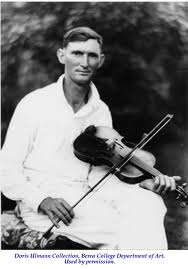Annotation:Indian Squaw (2): Difference between revisions
*>Move page script m (moved Talk:Indian Squaw (2) to Annotation:Indian Squaw (2)) |
m (Text replace - "[[{{BASEPAGENAME}}|Tune properties and standard notation]]" to "'''Back to [[{{BASEPAGENAME}}]]'''") |
||
| Line 1: | Line 1: | ||
[[{{BASEPAGENAME}} | '''Back to [[{{BASEPAGENAME}}]]''' | ||
---- | ---- | ||
<p><font face="garamond, serif" size="4"> | <p><font face="garamond, serif" size="4"> | ||
| Line 29: | Line 29: | ||
<br> | <br> | ||
---- | ---- | ||
[[{{BASEPAGENAME}} | '''Back to [[{{BASEPAGENAME}}]]''' | ||
Revision as of 13:24, 4 April 2012
Back to Indian Squaw (2)
INDIAN SQUAW [2]. Old-Time, Breakdown. G Major. GDad tuning (fiddle). AB. Some similarities to Alva Greene's version, although Hiram Stamper's [1] (1883-1992) apparently was derived from a song. Stamper whistled to the 'B' part of the tune, and sang to the 'A' part:
Way down yonder on the Arkansas,
Two old Indians and one old squaw,
Sitting on the banks of the Arkansas.
Jeff Titon (2001) finds nearly the same lyric in a song called "Bank of the Arkansas (The)" printed in Lomax and Lomax's Our Singing Country (1941, pp. 68-69), although Titon says tune that appears with that song is the same as that of Clyde Davenport's "Cornstalk Fiddle and a Shoestring Bow."

Source for notated version: Hiram Stamper (Hindman, Knott County, Ky., 1986) [Titon].
Printed sources:
Recorded sources: Titon (Old-Time Kentucky Fiddle Tunes), 2001; No. 69C, p. 99.
Back to Indian Squaw (2)
